#april 11th 1947
Explore tagged Tumblr posts
Text
Some of my favorite doodles from my headcanon/redesign concept sheets used as an excuse to list my headcanons about the main six (for an AU that I'm writing)! More under the cut!

Charlie Morningstar:
She's way more hot-headed than in canon, albeit still keeping her cheerful and gentle persona.
She loves food, and she's always hungry. I always loved the trope of protagonists (both male and female, like look at Goku himself, Usagi Tsukino or Minako Aino) and I think it could fit Charlie perfectly!
She loves planning (and this is already canon) and she has a lot of stationary gadgets. "Sure Alastor, you can borrow any pen! ... Not that one! :D" And takes good care of them.
Her birthday is February 29th. I thought that it wouldn't be strange if her birthday ended up being that day if she follows a demoniac calendar...

Vaggie:
It's canon that she likes everything to be clean and organized. I think she would help Niffty with the rooms and everything! They bond!
She and Angel Dust absolutely have BFFs vibes. Before Hazbin Hotel I remember they were meant to be a couple, but with the new canon they're still adorable as best friends and I love the dynamic more. They get into fights but it's never anything serious, they look like a big brother and a little sis, even though sometimes she definitely acts as a big sis to him. Angel sees Molly through her :(
As we know she doesn't really believe in herself, but she actually makes a very good leader!
In my fanfic, contrarily to the series, she was really fighting with burning hate towards the angels that cast her out. She holds a deep grudge and it's hard for her to come out of it. (I want Out for Love to be useful, it's my favorite song ç_ç)
Her name as a human was Agata Flores, she was born the 28th of June in 1993. If we still count 2014 as her death and if she was once a winner that then became sinner... my headcanon is that she died of a hate crime in March 25th 2014, aged 21.
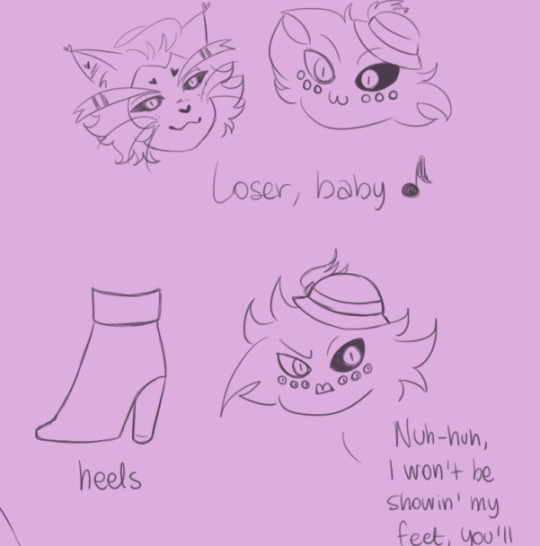
Angel Dust:
He's not in drag 24/7. He really is feminine, but sometimes likes to try masculine outfits too. (which make Husk wonder "why am I staring??")
He's secretly a nerd. Or not so secretly. He owns video games, and especially likes RPGs and life sims.
He overanalyses everything. Well, almost everything but still. He actually likes reading, and this led him to analyse anything that comes into his eye. (Oh, I can't wait to write one of those scenes because I already had fun outlining it LMAOO)
He's probably Charlie's food buddy. Give them some food and they'll be happy (Valentino doesn't like this but get screwed Val, give him food too)
His name as a human was Anthony (canon) Cavallaro and had Neapolitan heritage. He's born in April 1st (and this is canon) 1912, he died of overdose (canon) in October 11th 1947, aged 35.
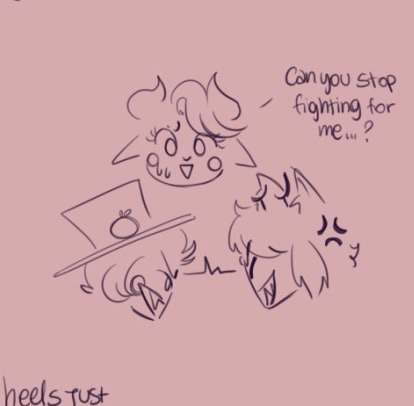
Alastor:
I loved his pilot persona more than the series', and most of the things are confirmed canon... but I do have some headcanons for him, too! (also yeah I don't think that will be my last radioapple drawing or doodle lol)
We know he either doesn't sleep or sleeps with his eyes open. Well, I imagine him that in the few rare occasions he actually sleeps, his radio works as a mental surveillance "camera". Also, he's a light sleeper and would definitely go "Do you fellows mind? I'm trying to sleep." like the old man he is.
I would like to explore Alastor's feelings for Charlie more, and how he sees her as a daughter. While we may not know if he was telling the truth, I think they both seeked each other as a fatherly and daughter figures in a way. Many in the fandom headcanon Alastor's father to have been shitty to him. If he truly sees Charlie as a daughter, it could be because he would like to be a better father than the one he had, and since he never had children, he grew affectionate to Charlie as such.
He knows how to handle alcohol well, but I like to think that when he's really drunk he doesn't even know what he's doing. Oh, you saw him playing with Angel's Nintendo Switch? He even brought it into his room to continue playing Animal Crossing by himself? He was totally wasted.
His name as a human was Alastor (which is apparently canon, but I wonder if it'll be retconned or not?) Boudreaux-Alexander. Boudreaux was his father's last name, Alexander was his mother's. He didn't like his mother taking her husband's last name and wanted to keep his mother's. He was born in March 7th 1901, and died in August 4th 1933, aged 32, after being shot by a hunter that confused him with a deer and was mauled by dogs afterwards. (Yikes, I'm so sorry)
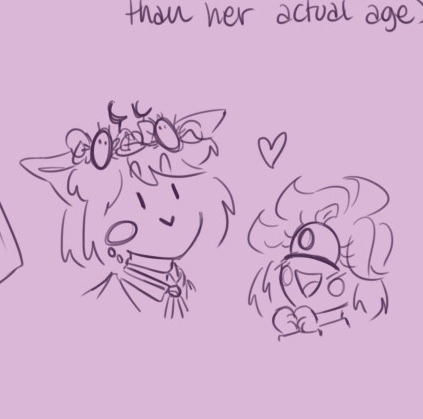
Niffty:
She definitely has written lots of fanfics about her fellow hotel friends. Especially men. Yet, she loves Charlie and Vaggie too, so they're there as well.
We know both Niffty and Husk have deals with Alastor. She loves them both, I love to headcanon that when she feels lonely and can't sleep well or had nightmares, she either goes to Husk's or Alastor's room to sleep with them. They welcome her warmly ç_ç
Alastor and Husk most definitely know Niffty's story, which is why they care about her so much. She's childish for her age, but it could be tied to a past that only the two of them know very well.
Niffty knew Vox when they were alive. Now I know it could be a weird headcanon since Niffty is Japanese and Vox is American, but if Niffty's work brought her around the world it wouldn't be weird if they crossed paths. When Vox died Niffty was 19, she either saw him die in front of her eyes or something else happened.
As I mentioned in my concept sheets, she used to wear glasses when she was alive so she can't see really well without them after she died. Sometimes she borrows Alastor's monocle, and if we apply the headcanon that he's colorblind, without his monocle not only he can't see anything but can't even see colors LOL
Her name when she was alive was Sachiko Tanaka, born February 27th 1934. She died September 1st 1956, aged 22, there are popular headcanons about the way she died and yikes, if it's true she didn't have a good death either. Not at all.
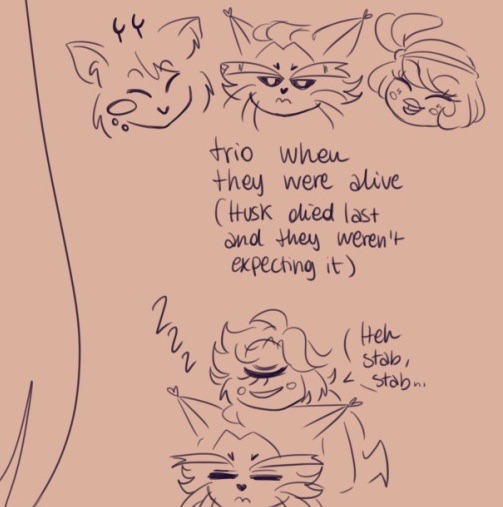
Husk:
Maybe I'm overanalysing but what if the reason why he grew affectionate to Niffty was because he once had children? Or just one? Either he had a child and was with him but felt like he wasn't a good father or his ex-wife left him because of his gambling addiction and this made him feel guilty, not able to see his child ever again. (I feel bad just thinking about this but ç_ç)
Despite the fact he hates being on a leash and none other than Alastor's, he actually cares about him. If the two were friends when they were alive (including Mimzy), this could explain why he's still around Alastor even if reluctantly. (Sure he says he's forced, but in the pilot Alastor summoned him, so it's safe to assume either Alastor-Husk-Niffty were roommates before coming to the hotel and did their business without telling Alastor, or simply we need more explanations of Alastor's deals)
His name when he was alive was Ivan Goncharov, born January 29th 1900, and died in December 23rd 1967, aged 67. As I mentioned in my concept sheets, he was friends with Alastor and Mimzy when they were alive and he was the last one of them to die. He would often visit his friends' graves when he was still alive :(
#hazbin hotel#hazbin hotel headcanons#hazbin headcanons#charlie morningstar#vaggie#vaggie hazbin hotel#hazbin hotel vaggie#angel dust#angel dust hazbin hotel#hazbin hotel angel dust#alastor#the radio demon#alastor hazbin hotel#hazbin hotel alastor#niffty#niffty hazbin hotel#hazbin hotel niffty#husk#husk hazbin hotel#hazbin hotel husk#chaggie#huskerdust#radioapple#art#artist on tumblr
140 notes
·
View notes
Text

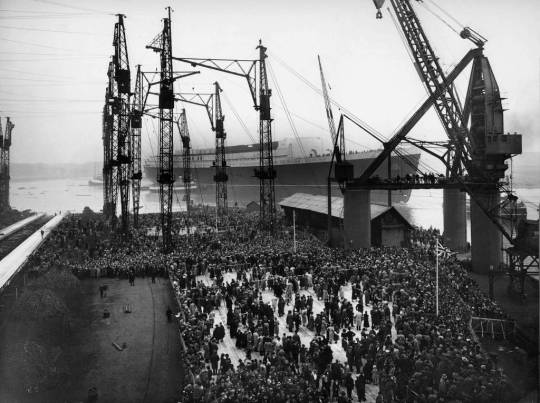

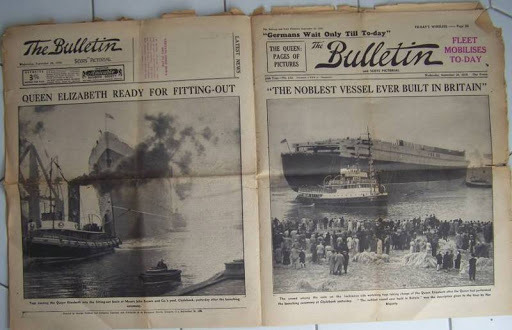
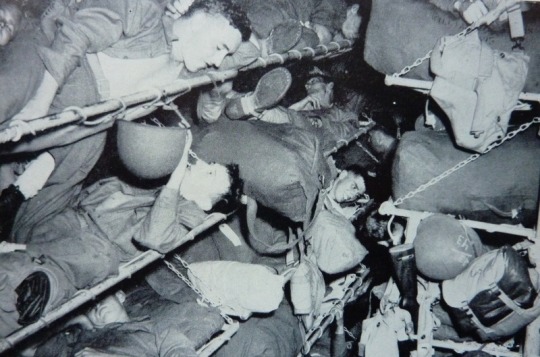
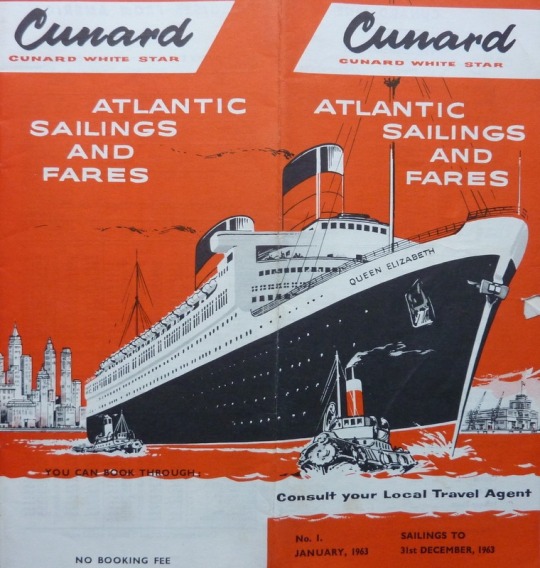
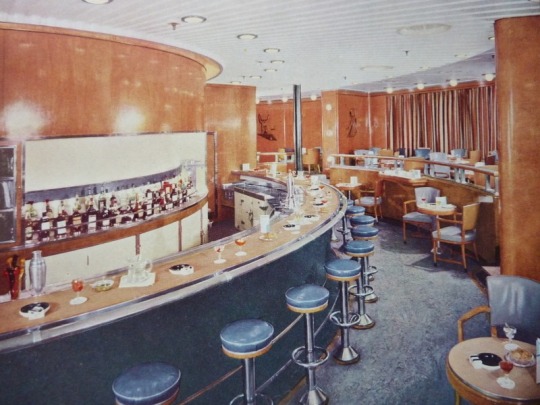
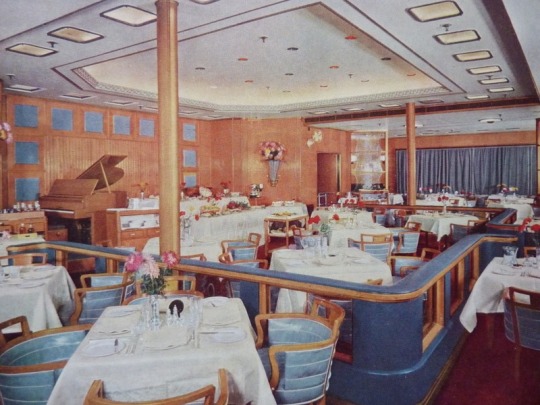
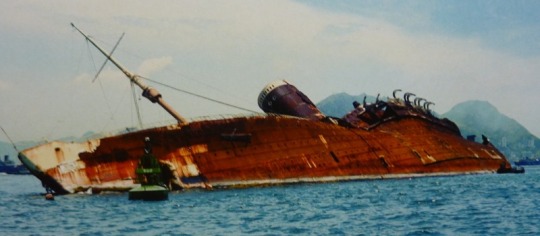

On September. 27th 1938, Queen Elizabeth, the world's largest ocean liner was launched on the Clyde.
The Queen Elizabeth was the sister ship of the Queen Mary, which was christened four years earlier, I covered this yesterday.
Unfortunately, her role as a luxury liner was short-lived - with the outbreak of the Second World War the following year, the Queen Elizabeth entered service in February 1940 as a troopship and didn’t return to her original role until October 1946.
The Cunard line’s enormous luxury ocean-goer was built on the river Clyde to sail between Southampton and New York, named after the Queen Consort (later the Queen Mother).
Following the outbreak of World War II, the security of Queen Elizabeth became a major concern for Cunard-White Star and the British Government. It was not safe to keep the ship in Scotland, as it was well known that she was a tempting target for the Luftwaffe.
Queen Elizabeth was painted in military grey before departing Clydebank for what was rumoured to be a short journey to Southampton. However, once in open sea the ship’s course was altered – Queen Elizabeth’s maiden voyage was to New York!
Thus, the untested and untried ship – then the world’s largest ocean liner – made a secret dash across the Atlantic to the safety of America. She arrived unannounced in New York, surprising officials and New Yorkers alike. Queen Elizabeth berthed alongside Queen Mary, Normandie and Mauretania Queen Elizabeth was requisitioned for wartime service on 13 November 1940.
The ship sailed to Singapore where she was refurbished into the world’s largest troop carrier. During the works, defensive armaments and a degaussing coil (to protect against mines) were fitted.
On 11th February, Queen Elizabeth sailed from Singapore bound for Sydney, Australia, arriving ten days later. Here the conversion into troop ship was completed and Queen Elizabeth undertook her first trooping voyage to the Middle East, carrying troops to Suez.
Queen Elizabeth later sailed to Canada, and carried troops to Sydney, while in 1942 the Admiralty considered possible future uses for the Queens. Their trooping capacity meant they were the most valuable large troop transports in service. When the USA entered the war in December 1941, the future use of Queen Elizabeth along with Queen Mary changed. Ultimately, the ships were most valuable operating the trooping service on the North Atlantic, and following a major overhaul Queen Elizabeth commenced this service. She remained in Government requisition for the rest of the war.
At the end of the war, Queen Elizabeth was famous on both sides of the Atlantic. The ship, which had carried over 750,000 troops, now commenced work repatriating those troops as well as the war brides.
Queen Elizabeth was released from Admiralty service in 1946. Her post-war overhaul and refurbishment was carried out both on the Clyde and at Southampton. This overhaul saw luxury passenger interiors installed aboard Queen Elizabeth, in preparation for civilan transatlantic services. Additionally, ship was painted in Cunard livery, while the machinery was overhauled.
Queen Elizabeth was given her full sea trials, and then officially accepted by Cunard. The ship made her maiden peacetime passenger voyage to New York on 16 October 1946.
Queen Elizabeth proved a popular ship and over the coming months the ship was well booked. On 17 April 1947, Queen Elizabeth ran aground near Brambles Bank as she made her approach to Southampton in thick fog. The ship was later successfully refloated.
In September 1951 Queen Elizabeth made her 100th peacetime transatlantic crossing. But as more passengers took to airline services, Cunard realised that they needed to upgrade Queen Elizabeth in order to keep her relevant in a changing world with a particular focus on longer duration cruising
As such, during a refurbishment in January 1952 the ship’s fuel capacity was increased allowing her to sail longer distances without refuelling. Additionally air-conditioning was fitted throughout, to allow the ship to undertake voyages into warm climates. Four years later, Queen Elizabeth was fitted with stabilisers, which greatly improved passenger comfort.
When Pan American World Airways flew the first Boeing 707 service across the Atlantic, the future for Queen Elizabeth was in doubt. By 1962 the decline in the number of passengers on the Atlantic shipping service (they had moved their business to airliners) led to an announcement that the ship would be used more and more for cruises.
Cunard gave Queen Elizabeth another major overhaul in Greenock, which involved an interior refurbishment and the creation of an outdoor swimming pool on Queen Elizabeth’s aft deck. This was combined with a new lido area which, it was hoped, would allow the ship to attract more cruise passengers.
Sadly, the 1966 Seaman’s Strike meant that the refreshed ship was laid up in Southampton for a number of weeks, which further impacted on Cunard’s financial viability. On 8 May 1967, Cunard announced the fates of the two Queens. Queen Mary was withdrawn from service later that year, while the Queen Elizabeth was to be retained until Autumn 1968, by which time it was hoped the QE2 would be ready as her replacement.
Queen Elizabeth was initially sold to a group of Philadelphian businessmen, who intended to turn her into a floating hotel in Florida. The ship made her final transatlantic crossing on 5 November 1968 before she was withdrawn from Cunard service.
Once in Florida, the ship was opened to the public, however this venture didn’t last and the ship was closed in late 1969. In 1970 the ship was auctioned and bought by C.Y.Tung, Hong Kong, who planned to convert the liner into the world’s largest Floating University.
Re-named Seawise University, the ship sailed for Hong Kong to be converted. The transformation was almost complete when a series of fires broke out aboard the ship, causing her to burn out and sink in the harbour, a sad end to a beautiful ship.
You can find more pics and info on the link below, including an 8 minute video. Among the pics you will see that although Queen Elizabeth was a luxury liner, it was not this way when it was in service during WW2, troops were crammed into every available space.
17 notes
·
View notes
Text

Emma Reed (Wright) (May 30, 1925 - April 4, 2014) was born on the family farm in rural Redwood, Mississippi to Sallie and Smith Reed. She grew up on the farm but attended Coleman High School in Greenville. She enrolled in Tennessee State University where she obtained a BS in Health and Physical Education. She enrolled in New York University, graduating with an MA in Engineering.
She joined the Track and Field Team as a long and high jumper. She set records at Tennessee State. In 1947 she claimed the AAU Junior title in the high jump. In 1948 she finished second nationally at the AAU Outdoors Meet in London in the high jump and was victorious at the AAU Indoor high jump championship.
She was one of only 34 athletes from Tennessee State to participate in the Olympics. She got her first chance for glory and a gold medal at the 1948 Olympics in London. She was 23 years old when she took part in the Women’s Long Jump for Team USA which ranked 12th in the international competition. Her best jump had a distance of 5.290 feet which was tied for 11th during the competition. This number moved her to the Final Round where she achieved a distance of 4.845 ranking 12th overall.
She participated in the Women’s High Jump for Team USA where she tied for 14th in the event. She achieved a height of 4.6 feet which was her overall personal best.
She returned to Tennessee State at the end of the Olympic games. She resumed her studies and graduated from State. She began teaching African American history at Barber-Scotia College.
She married Julius Wright (1960-61). There were no children from the marriage. She began teaching at Leland Junior High in DC. She became a tennis coach at the William H.G. Fitzgerald Tennis Center in Rock Creek Park.
She moved to Seattle to be close to her family. She was a devout Christian who attended Bethany Community Church. #africanhistory365 #africanexcellence
13 notes
·
View notes
Text
My Au William Afton timeline-Part one
This covers his birth all the way to his first death
Born March 2 1949 to Robert “Rob” Afton and Violeta Watson Afton, he has two older siblings, Eleanor Afton , who was born 1945, and Thomas “Tommy” Afton, who was born in 1947. He also has an older half brother named Vincent Paars, who was the product of an affair Violeta had with a American solider in 1944. William was born in York, Britain. His mother was incredibly doting to him, as he was a rainbow baby. This would later fester into extreme narcissism.
His younger Sister Jane is born in 1950
His Younger brothers Robert “Bobby” Afton Junior and Charles “Chuck” Afton are born in 1952
In 1955, Violeta would poison her husband and children, with the exception of William and Vincent, who lived with his fathers wife. Eleanor would survive, and as a result, be sent away to a catholic school for girls. William was 6 years old.
On November 1st, 1956, when William was seven, they would move to London, where Violeta would meet Oscar Anderson.
On February 9th, 1957, Violeta would Marry Oscar after only three months of dating. This event would anger William. Oscar would go on to verbally abuse him.
On April 14th, 1957, William would kill a small rabbit on his school playground, causing him to be expelled from the school, he would later switch to a private school. He would continue to kill small animals, and hurt children younger and smaller than him
On October 12, 1957, Eleanor would return from the catholic school, having been expelled. This would cause William to grow more upset with his home situation, he wanted to Kill Eleanor.
On October 21st, 1962, William would shove Eleanore hands into a deep fryer, hoping to kill her with it, he was unsuccessful. Eleanore would be scared for life both in her hands and in her head.
On July 3rd, 1967, Oscar and William would get into a fight about him wanting to go to America for college, ending with William pushing him off a balcony, killing Oscar upon impact with the floor
On August 6th, William would depart for college, attending American Academy with a major in business and minor in robotics.
On Christmas of 1968, William meets Isabella Rodriguez, who he becomes infatuated with
On November 2nd, 1969, William gives birth to his first child, Micheal Afton, with Isabella being the mother. After this, his mother tells him to not marry her, he listens. He begins to claim the baby is not his. This results in a long custody battle which ended in 1972. William would gain full custody of Micheal.
On February 14, 1972, William meets both Henry Emily and his then girlfriend Lauren Jones, he and Lauren get very close and he later marries her when she and Henry break up. He becomes quick best friends with Henry.
On June 11th, 1973, Lauren gives birth to Elizabeth Afton, his second child. After her birth, William slowly withdrew from Micheal, causing him to become confused. About a year later, Henry and his wife Luiya give birth to Charlotte “Charlie” and Samuel “Sammy” Emily.
On August 18th,1975, Lauren gives birth to Evan Garret Afton, his third and final child and second son. He starts becoming more abusive and neglectful towards Micheal.
On September 3rd, 1979, Henry Emily and William open Fredbears family dinner. Combing Henry’s creativity and Williams eye for business. The restaurant becomes a smash hit, especially with its unique spring lock animatronics, which act as both animatronic performers and mascot costumes.
On May 6th, 1982, William would go through a spring lock accident. He would have to have a surgery to get some metal parts out of him. The scars of the accident would remain on him for the rest of his life.
On August 18th, 1983, Evan Afton would be killed in the jaws of the Fredbear animatronic, caused by a prank Michael and his friends pulled. William wouldn’t necessarily mourn his son, as he saw him as a weak crybaby, and his rage toward Micheal was more severe than any sadness he had.
On January 6th, 1984, About a week after it opened,Elizabeth would be killed by Circus Baby, the animatronic designed to kill children. He would feel a slight bit of guilt about it, but he more saw it as a learning opportunity. Charlie Emily would be a witness to this event, and would tell Henry. Circus babies would be closed immediately after.
On July 10th, 1985, Henry and William open Freddy and Friends
On October 31st, 1984, William would Kill Charlie, hoping to silence her, in this event, he would discover remnant, he would use it to experiment on. Henry would be traumatized by this incident, and becomes depressed, making it easier for William to manipulate him.
During the summer of 1985, William would murder five children, one of them being the best friend of his late son and daughter of a employee , Cassidy Guerra. He would frame the event on Employees Jack Kennedy and Dave Miller. They would be arrested the following September.
On September 19th, 1985, Fredbear and Friends, which at this point had been rebranded as Freddy Fazbears Pizza, would close.
On March 10th 1986, Lauren would divorce him, after years of an unfulfilling and abusive relationship. He would skip town after suspicion of him being the real killer would come out, and Jack and Dave’s release. That following night, he would go to Freddy’s to get more remnant, Jack would meet him there and shot him with a pistol. William would use remnant to heal himself, making him immortal
On April 14th, 1993, William would begin working at Freddy Fazbear pizza as a brief night guard until it would open that next month.
On April 17th, William would destroy the beat down animatronics, releasing the sprits. The ghosts would chase him into the back room where they had been murdered several years prior. As a way to hide, and taunt them, William would put on the spring Bonnie suit, laughing hard as he did. Unfortunately for him, the 14 year old suit did not respond well to the heavy movement, not to mention the leaking ceiling. The combination off the movement and water caused the spring locks to go off, killing him instantly.
#fnaf#fnaf au#william afton#five nights at freddy’s#micheal afton#elizabeth afton#evan afton#henry emily#mrs. afton#charlie emily#sammy emily#jack kennedy#dayshift at freddy's
5 notes
·
View notes
Text
Top 5 @Wikipedia pages from yesterday: Thursday, 11th April 2024
Welcome, tervetuloa, добродошли (dobrodošli), bienvenue 🤗 What were the top pages visited on @Wikipedia (11th April 2024) 🏆🌟🔥?

1️⃣: O. J. Simpson "Orenthal James Simpson (July 9, 1947 – April 10, 2024) was an American football player, actor, and convicted felon. He played in the National Football League (NFL) for 11 seasons, primarily with the Buffalo Bills, and is regarded as one of the greatest running backs of all time. Once a popular..."

Image by Gerald Johnson
2️⃣: Fallout (American TV series) "Fallout is an American post-apocalyptic drama television series created by Graham Wagner and Geneva Robertson-Dworet for Amazon Prime Video. It is based on the role-playing video game franchise created by Interplay Entertainment and now owned by Bethesda Softworks. Amazon purchased the rights to..."
3️⃣: Nicole Brown Simpson "Nicole Brown Simpson (née Brown; May 19, 1959 – June 12, 1994) was married to the professional American football player O. J. Simpson from 1985 to 1992. She was the mother of two children-- daughter, Sydney Brooke, and son, Justin Ryan. Two years after her divorce from Simpson, Brown was stabbed to..."
4️⃣: Cyberterrorism "Cyberterrorism is the use of the Internet to conduct violent acts that result in, or threaten, the loss of life or significant bodily harm, in order to achieve political or ideological gains through threat or intimidation. Acts of deliberate, large-scale disruption of computer networks, especially..."
5️⃣: Murder trial of O. J. Simpson "The People of the State of California v. Orenthal James Simpson was a criminal trial in Los Angeles County Superior Court starting in 1994, in which O. J. Simpson, a former National Football League (NFL) player, broadcaster and actor, was tried and found not guilty for the murders of his ex-wife..."

Image by Superior Court of the State of California, Los Angeles
0 notes
Text
Here Mary Pickford, Charlie and wife Oona attend premiere.




Charlie Chaplin's MONSIEUR VERDOUX premiered in New York City #OnThisDay in 1947.
24 notes
·
View notes
Photo


Charlie Chaplin with Mary Pickford on his right arm and lovely wife Oona on his left. Attending Premiere of “Monsieur Verdoux”, Broadway Theatre, New York City, April 11th 1947.
Mary Pickford appears to want to be anywhere, but there. She and Charlie were still partners in United Artists. It was felt her public support would help the film’s reception. It did not work, in fact some sitting in the theatre hissed at the film. Charlie quite upset at this reaction went and stood in the lobby while Mary and Oona sat through it.
By 1947, Charlie Chaplin was starting to feel a backlash from the press and the public. In fact the press that met with him the next day at the Gotham Hotel, treated him quite different than seven years prior, on the occasion of “The Great Dictator”, when the press had met him with open arms.
22 notes
·
View notes
Note
heyyy sophieee!!
I need the birthday headcannons for ur au, I know u made a post but I cannot find them for the life of me. Please and ty :>
As of April, 1970;
Buck Merrill’s birthday is August 5th, 1945, making him 25
Tim Shepard’s birthday is November 5th, 1947, making him 23
Dallas Winston’s birthday is November 9th, 1947, making him 23
Sylvia Jackson-Merrill’s birthday is December 17th, 1947, making her 23
Curly Shepard’s birthday is December 3rd, 1950, making him 20
Angela Shepard’s birthday is December 4th, 1951, making her 19
Loretta Jackson-Merrill-Dawson-Shepard’s birthday is April 11th, 1967, making her a few days from her third birthday at the start Dead Man Walking
#soapie’s stuff#asks!#aint we the hoi polloi#the outsiders#the outsiders hcs#soapie’s oc’s#dead man walking
15 notes
·
View notes
Text

• U.S Army Nurse Corps
The United States Army Nurse Corps (AN or ANC) was formally established by the U.S. Congress in 1901. 96% of the 670,000 wounded soldiers and sailors who made it to a field hospital staffed by nurses and doctors survived their injuries. By the end of the war, the Army and Army Air Forces (AAF) had 54,000 nurses and the Navy 11,000—all women.
Nurses served in Washington's Army during the Revolutionary War. Although the women who tended the sick and wounded during the Revolutionary War were not nurses as known in the modern sense, they blazed the trail for later generations when, in 1873, civilian hospitals in America began operating recognized schools of nursing. Professionalization was a dominant theme during the Progressive Era, because it valued expertise and hierarchy over ad-hoc volunteering in the name of civic duty. The Army Nurse Corps became a permanent corps of the Medical Department under the Army Reorganization Act (31 Stat. 753) on February 2nd, 1901. Nurses were appointed in the Regular Army for a three-year period, although nurses were not actually commissioned as officers in the Regular Army until forty-six years later-on in April 1947. The number of nurses on active duty hovered around 100 in the years after the creation of the corps, with the two largest groups serving at the general hospital at the Presidio in San Francisco and at the First Reserve hospital in Manila. In World War I (American participation from 1917–18) the military recruited 20,000 registered nurses (all women) for military and navy duty in 58 military hospitals; they helped staff 47 ambulance companies that operated on the Western Front. More than 10,000 served overseas, while 5,400 nurses enrolled in the Army's new School of Nursing.
Demobilization reduced the two corps to skeleton units designed to be expanded should a new war take place. Eligibility at this time included being female, white, unmarried, volunteer, and a graduate from a civilian nursing school. In 1920, Army Nurse Corps personnel received officer-equivalent ranks and wore Army rank insignia on their uniforms. However, they did not receive equivalent pay and were not considered part of the US Army. At the start of the war in December 1941, there were fewer than 1,000 nurses in the Army Nurse Corps and 700 in the Navy Nurse Corps. All were women. Due to the Japanese attack of Pearl Harbor on December 7th, 1941, the United States entered the Pacific part of World War II. Along with this military effort was the work of the Flying Tigers in Kunming, China, under Claire Chennault. Nurses were thus needed in China to serve the U.S. Army. These nurses were recruited among the Chinese nurses residing in China, particularly the English-speaking nurses that fled Hong Kong (a British colony) to free China due to the Japanese invasion of Hong Kong on December 8th, 1941.
Only a few African American nurses were admitted to the Army Nurse Corps. Mabel Keaton Staupers, who worked for the National Association of Colored Graduate Nurses with help from Eleanor Roosevelt, pressured the Army to admit African American nurses in 1941. The first black nurse admitted to the program was Della H. Raney who was commissioned as a second lieutenant in April of 1941. The limit on black nurses was 48 in 1941 and they were mostly segregated from white nurses and soldiers. In 1943, the Army set a limit on black nurses to 160. That same year, the first African American medical unit, the 25th Station Hospital Unit, was deployed overseas to Liberia. Later, nurses were deployed to Burma, where they treated black soldiers. African American nurses also served in China, Australia, New Guinea, the Philippines, England and in the US where they treated prisoners of war. Some 217 black nurses served in all-black Army medical units.
Throughout 1941 the United States had responded to the increasing tensions in the Far East by deploying more troops in the Philippines. The number of Army nurses stationed on the islands grew proportionately to more than one hundred. Most nurses worked at Sternberg General Hospital in Manila and at Fort McKinley, 7 miles outside the city. However, a few nurses were at Fort Stotsenberg, 75 miles north of Manila, and two worked at Camp John Hay, located 200 miles to the north in the mountains. Several nurses worked on the island of Corregidor. Six months after the Japanese bombed Pearl Harbor, there were 12,000 nurses on duty in the Army Nurse Corps. Few of them had previous military experience, and the majority reported for duty ignorant of Army methods and protocol. Only in July 1943 did Lt. Gen. Brehon B. Somervell, Commanding General, Army Service Forces, authorize a formal four-week training course for all newly commissioned Army nurses. This program stressed Army organization; military customs and courtesies; field sanitation; defense against air, chemical, and mechanized attack; personnel administration; military requisitions and correspondence, and property responsibility. From July 1943 through September 1945 approximately 27,330 newly inducted nurses graduated from fifteen Army training centers. More than 2,000 nurses trained in a six-month course designed to teach them how to administer inhalation anesthesia, blood and blood derivatives, and oxygen therapy as well as how to recognize, prevent, and treat shock. In December 1943 the U.S. War Department decided that there were enough nurses in the Army Nurse Corps to meet both existing and anticipated future demands on the Army. Consequently, the Army instructed the American Red Cross, which throughout the war had been responsible for the recruitment of nurses for the Army Nurse Corps, to stop recruiting. The Red Cross sent telegrams to local volunteer committees in every state advising them to discontinue their sustained drive to enlist nurses.
In November 1942 the United States invaded North Africa to link with British forces in the North Africa campaign. The Army nurses who participated in the North African invasion at first had little conception of the realities of battle and were unfamiliar with military procedures. One nurse at the Arzew hospital became so incensed at snipers firing into the windows of the hospital and endangering the patients that she had to be forcibly restrained from going outside to "give them a piece of her mind." Nurses serving at the front in North Africa became expert at meeting the challenges of combat while caring for incoming patients. In February 1943 when news reached the 77th Evacuation Hospital bivouacked near Tebessa that the German Army had broken through the Kasserine Pass, staff members packed up and moved their 150 patients sixty miles to a safer bivouac. Within twelve hours a new hospital was fully operational and received another 500 casualties. During the Allied counterattack from mid-April through May 1943, which captured northern Tunisia, the 77th treated 4,577 soldiers within a 45-day period. The nurses' performance during the North African invasion taught the Army several lessons that it applied to the invasions of Sicily and southern Italy. Commanding officers noticed that nurses acclimated quickly to difficult and dangerous conditions with a minimum of complaints.
Their efficiency and professional accomplishments made them essential members of the field armies. The presence of nurses at the front improved the morale of all fighting men because soldiers realized that they would receive skilled care in the event they were wounded. Hospitalized men recovered sooner when nurses cared for them. Troops in the field figured that "if the nurses can take it, then we can." U.S. and British troops invaded Sicily on July 9th, 1943, and nurses of the 10th Field Hospital and the 11th Evacuation Hospital arrived on the island three days later. There they were greeted by German Stuka dive bombers which forced them into slit trenches and foxholes during the first few days. Other nurses scheduled to support the invading U.S. Seventh Army had to wait nine days for transport, which was in short supply during the first week of the invasion. Continuous periods of bad weather caused one of the most famous incidents in Nurse Corps history. On November 8th, 1943, a C-54 ferrying thirteen flight nurses and thirteen medical technicians (corpsmen) of the 807th Medical Air Evacuation Transport Squadron from Sicily to Bari on the east coast of Italy ran into severe weather. The plane lost radio contact, the compass failed, and the pilot became disoriented in the storm. Icing finally forced the plane down in the Albanian mountains far behind German lines. Partisan guerrillas found the Americans and took them to a nearby farmhouse. That night the flight crew set fire to the plane to conceal traces of their presence in the area. In bitterly cold weather and blinding snowstorms, the small band made a hazardous, two-month journey covering 800 miles. The escapees suffered from frostbite, dysentery, jaundice, and pneumonia, but all the nurses except three who were separated from the main body of the group arrived safely. Throughout February and March, medical installations on the beachhead continued to receive direct hits. On March 29th, 1944 the 56th Evacuation Hospital was shelled, leaving 3 officers, 1 nurse, 14 enlisted men, and 19 patients wounded and 4 patients killed. Whenever the air raid sirens at Anzio sounded, those patients who could put on their steel helmets and crawled under their cots to avoid flying shrapnel. Nurses and corpsmen lifted others to the ground. Patients whose condition rendered them immovable became very nervous, and nurses ignored the danger to stay with them. A later observer explained that the medical detachment at Anzio was "part of a front that had no back. medical installations earned it the nickname "Hell's Half Acre." Many soldiers believed that they were safer in their frontline foxholes than they would be in the hospitals.
By June 1945 the number of Army nurses in the European theater of the war reached a peak of 17,345. The first nurses to arrive in Normandy were members of the 42d and 45th Field Hospitals and the 91st and 128th Evacuation Hospitals. They landed on the beachhead four days after the initial invasion in June 1944. The nurses' experiences in the European theater varied widely, depending upon their assignments. The experiences of those assigned to the 12th Evacuation Hospital reflected that diversity. Unit members sailed for England in January 1943. After several moves they arrived on the east coast of England in May 1944. There they participated in the buildup for the Allied invasion of the Continent by establishing a tent hospital and preparing for the expected influx of casualties. In early June they watched hundreds of Allied planes fly overhead to prepare the way for the invasion. The 12th Evacuation Hospital deployed to France in July, arriving in Normandy in August. By that time most of the heavy casualties incurred during the first weeks of the invasion had already been evacuated to England. Throughout August Allied forces pushed the German Briny eastward through France toward the Siegfried Line. The front moved rapidly; high numbers of casualties occurred only in pockets of resistance and were handled by other evacuation hospitals. In mid-September the Allies met the German defenses at the Siegfried Line, and casualties mounted. The 12th established operations at Bonneval, where it admitted 1,260 patients in less than one month. The nurses of the 12th moved eleven times in two years. After each relocation they had to prepare a sanitary, comfortable hospital capable of handling large numbers of critically wounded or sick patients. Their experience alternated between periods of exhausting activity and intense boredom. They had to be flexible, innovative, quick-thinking, patient, adaptable, and highly skilled. Nurses frequently demonstrated their ability to remain calm in unpredictable and dangerous situations. For example, flight nurse Reba Z. Whittle's C-47 was caught by flak and crashed behind enemy lines in September 1944. Every member of the crew, including Whittle, was wounded. The Germans provided their prisoners with medical care and upon their recovery incarcerated them in Stalag IXC. Whittle's captors allowed her to nurse other POWs throughout her captivity. Whittle was held as a prisoner of war for five months until her release in January 1945.
After American and British forces repulsed this last German offensive, medical units accompanied the Allied forces into Germany. In newly conquered, hostile territory the nurses experienced new pressures. Third Army nurses noticed that the deeper the Americans went into Germany, the more openly hostile German civilians became. Near Darmstadt, the hospital had to be guarded at all times. According to one nurse, German civilians looked at the nurses "with actual hatred in their eyes—and children throw stones at ambulances and spit at jeeps." The final push into central Germany cost the western Allies heavy casualties and required medical units to work under great pressure. The 44th Evacuation Hospital admitted 1,348 patients from the 3d Armored Division during one 56-hour period in mid-April. Casualties also came in from the 9th Infantry, engaged in clearing out the area north of the Harz Mountains. This expect and many like it were how nurses in the European theater experienced the final days of WW2 in Europe. With over 8 million soldiers and airmen, the needs were more than double those of World War I. Hundreds of new military hospitals were constructed for the expected flow of casualties. Fearing a massive wave of combat casualties once Japan was invaded in late 1945, President Franklin D. Roosevelt called on Congress early in 1945 for permission to draft nurses. However, with the rapid collapse of Germany early in 1945, and the limitation of the war in the Pacific to a few islands, the draft was not needed and was never enacted.
There is no single comprehensive history of the U.S. Army Nurse Corps, nor is there a volume in the official United States Army in World War II series that deals with this corps. The best approach to learning more about Army nurses during World War II is to read the relatively few individual memoirs which have been published over the years. The following are among the best. In From Nightingale to Eagle: An Army Nurses History (1973), GI Nightingale: The Story of an American Army Nurse (1945). In Jungle Angel: Bataan Remembered (1988) and many other stories which detail the experience of these brave women near the frontline fighting to keep men alive. Members of the Army Nurse Corps served in Theaters all over the world. They often had to live and work under trying conditions, treating others and suffering themselves from tropical illnesses and diseases, adapting to different climatic conditions. Moreover, Nurses had to cope with inadequate supplies and lack of adapted Theater clothing. Some came under fire, others were taken prisoner, and many had narrow escapes. Deaths were unavoidable, due to hazardous duty. In total, over 59,000 Nurses served in the Army Nurse Corps during World War 2.
#world war 2#second world war#world war ii#wwii#military history#history#us army#nursing#nurses#womens history#women's history month#american history
118 notes
·
View notes
Photo

Springtime in Brooklyn by Nancy Rosoff, Andrew W. Mellon Senior Curator, Arts of the Americas
As I look out my window at the falling rain, I know that these April showers will soon be followed by May’s flowers. The vibrant colors of budding trees and blossoming flowers give us hope that we will overcome the current crisis, and the world will be rejuvenated, stronger, and more unified. The following works from the Brooklyn Museum’s diverse collection celebrate the arrival of Spring and our hope for a healthy and more peaceful world.
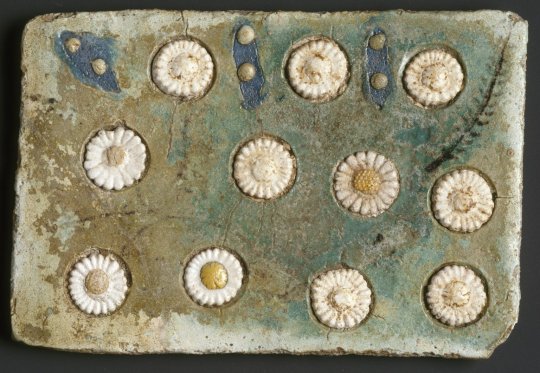
Brightly colored plants and flowers made of faience once decorated the walls of the Great Palace of king Akhenaten at Amarna. Sun light and the disk of the sun itself became the focus of religious worship in the Amarna period (1353-13336 B.C.E.). The floral motifs of these tiles were meant to evoke rebirth of life brought about by the sun. See the artwork in our open collection.
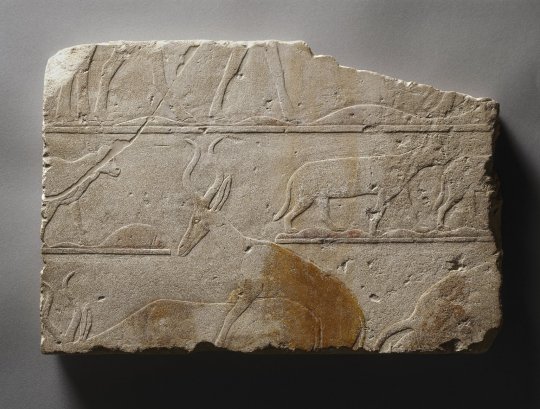
While the Nile was revered as a life-giving place, the desert was also teeming with nature. Here one can see animals breeding in their desert environs. To the right, a feline is showing interest in another feline. At the lower left, a male antelope, mounting his mate, rears his head into the row above. At the lower right, the hindquarters of an antelope giving birth and the emerging head of her calf are partly preserved. The bovine calf at center left completes this depiction of the cycle of life. See the artwork in our open collection.
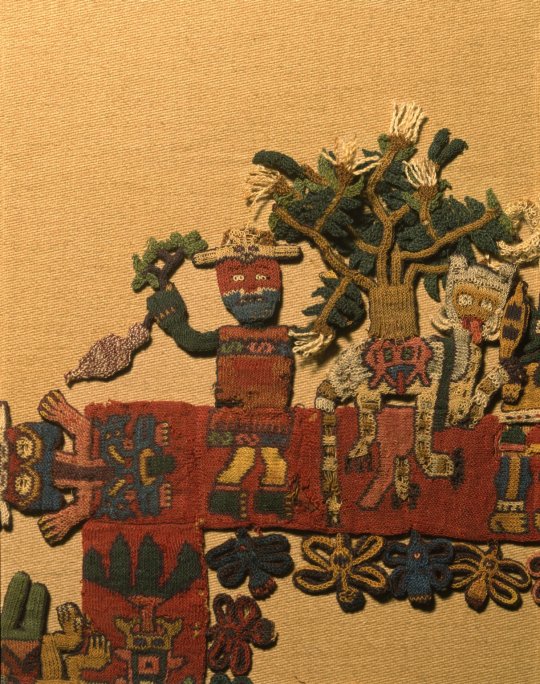
This detail from a Nasca mantle not only illustrates some of the plants and animals native to Peru’s South Coast, but it also conveys how the society’s spiritual beliefs are connected to agricultural seasons. The blossoming huarango tree seen here represents life and is shown growing out of a human trophy head on the back of a pampas cat. The trophy head symbolizes death but it is also a germinating seed from which life sprouts in a never-ending cycle of life, death, and rebirth. See the artwork in our open collection.

This late-seventeenth-century painting from viceregal Peru shows Saint Joseph standing hand-in-hand with the Christ Child in a field of blooming flora and enclosed within a border of bright carnations and lilies. Saint Joseph’s popularity flourished at this moment in the Spanish Americas as he embodied ideals of fatherhood, marriage, divinity, and masculinity. Here, he holds a stem of white lilies, which symbolize his holiness and purity. See the artwork in our open collection.
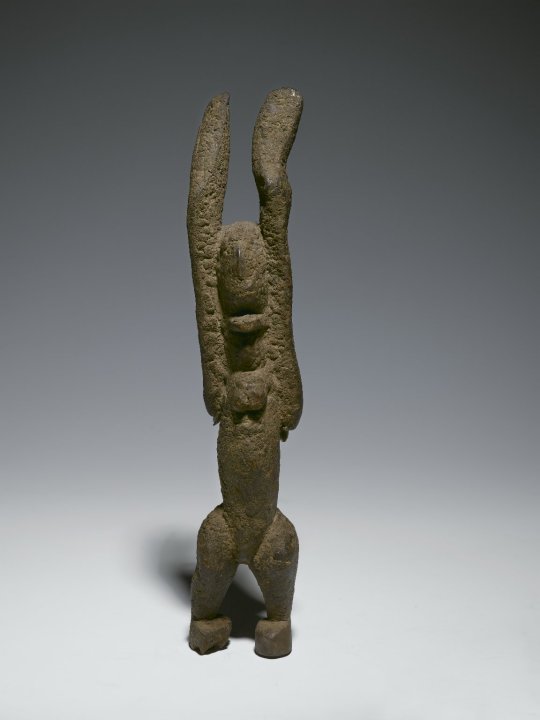
This sculpture would have served as a means for people to contact spiritual intermediaries for aid. Its raised arms are said to refer to prayers for rain, crucial to survive and thrive in arid the Mopti Region of Mali. See the artwork in our open collection.
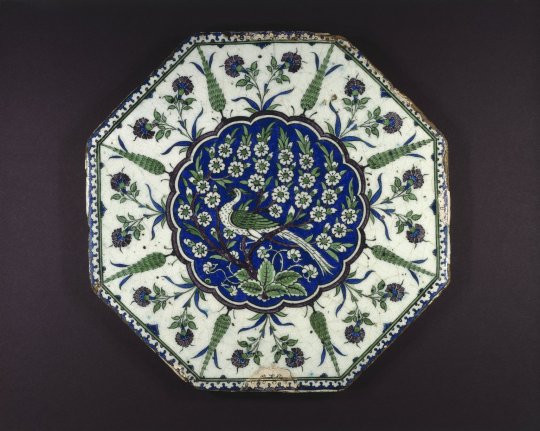
The use of naturalistic floral motifs, such as carnations, tulips, and hyacinths, was a trademark of the design workshop of the Ottoman court in Istanbul in the mid-sixteenth century. This design principle was adopted in central and distant areas of the empire and applied to different media, such as manuscript illuminations made in Istanbul, textiles made in Bursa, and tiles made in Iznik and Damascus. This octagonal tile from Syria brings the beauty of spring indoors permanently. See the artwork in our open collection.
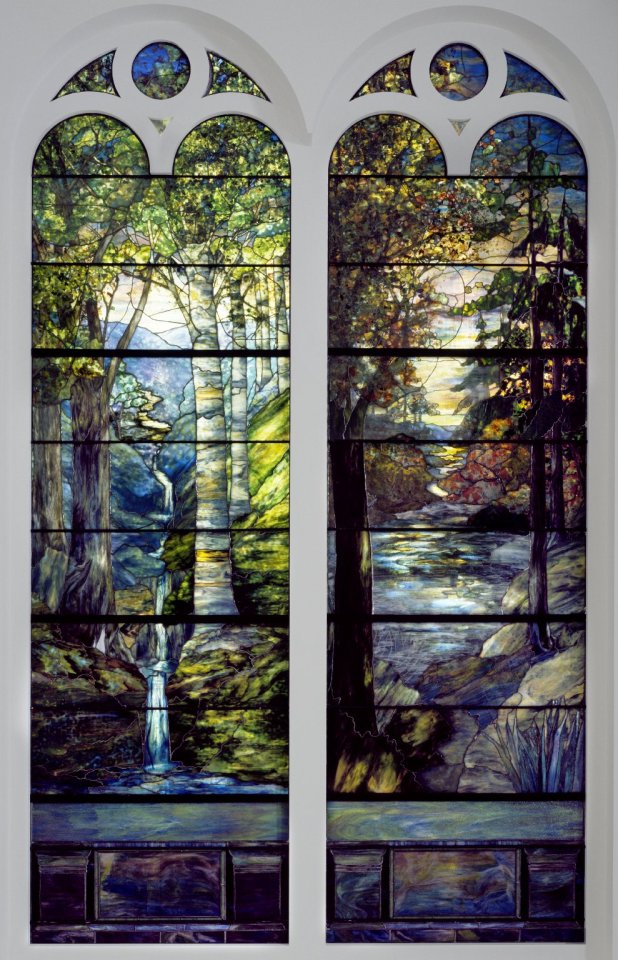
Vibrant greens and blues bring a spring woodland scene inside the Museum, creating an eternal verdant landscape. The effects of changing sunlight or a passing cloud can animate the glass used to depict the stream, tree trunks and leaves. Originally installed in the Universalist Church of Our Father at Classon and Atlantic Avenues in Brooklyn, the windows were purchased by the All Souls Universalist Church on Ocean Avenue and installed in 1945, before coming to the Brooklyn Museum a few years ago. Tiffany Studio was extremely skilled at creating panoramas that open onto lush, brilliantly colored vistas. See the artwork in our open collection.
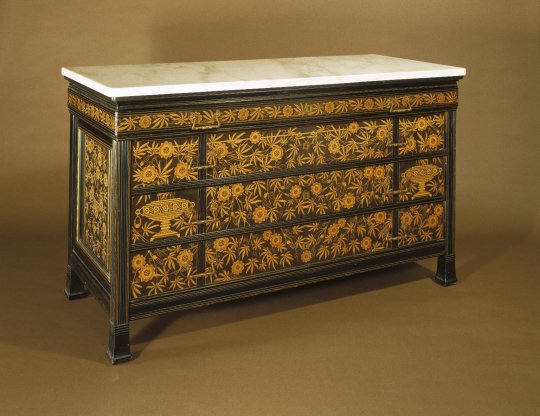
This elaborately decorated cabinet brought ever-blooming flowers into the owner’s bedroom. Inspired by Japanese precedents, New York’s most important late-19th-century furniture manufacturing firm Herter Brothers employed different colored woods to create the densely packed, abstracted flowers and leaves on this luxurious, yet functional chest-of-drawers. See the artwork in our open collection.
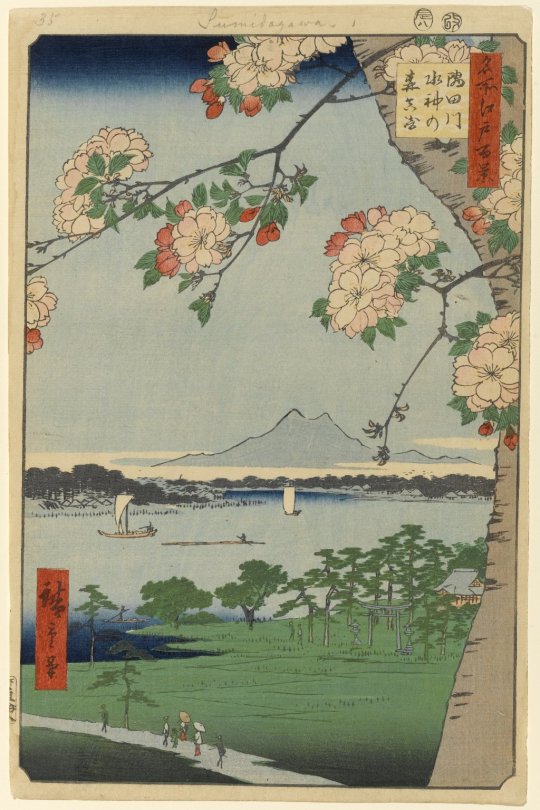
In the Japanese tradition, cherry blossom season is a time for celebration: the world wakes up after a long winter and people head outside to gather under the pink-and-white canopies created by trees that seemed barren only a week or two earlier. This year the picnics were cancelled, but in nature the show goes on whether there’s an audience or not. See the artwork in our open collection.
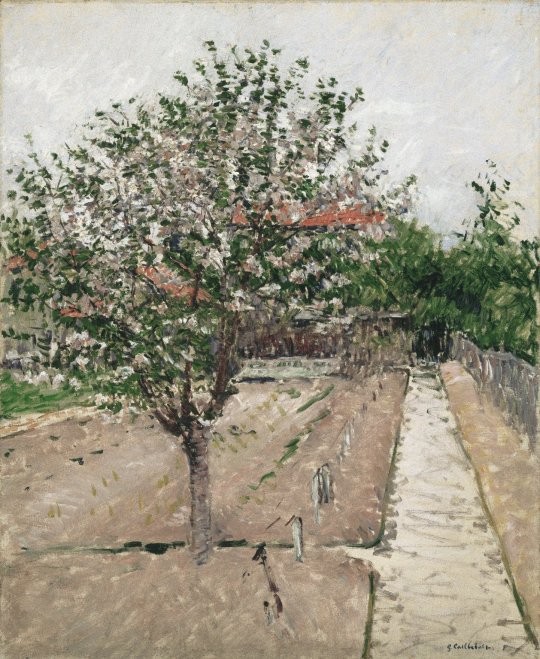
In this painting, Gustave Caillebotte offers a glimpse of his private garden in Petit Gennevilliers, a small village on the Seine opposite Argenteuil. The apple blossoms are rendered in thick touches of paint, which contrast with the sketchy treatment of the path that leads toward the denser foliage beyond the tree. See the artwork in our open collection.

Nothing celebrates Spring more than this dazzling child’s cap with its delicate beadwork on vibrant rose-colored velvet. It was lovingly made by the mother or female relative of a little girl who would have worn it with pride during special occasions. See the artwork in our open collection.
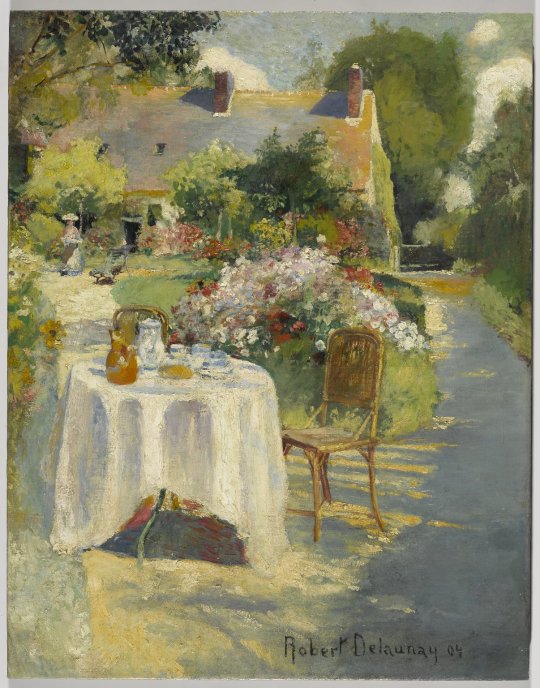
A table set with bread and coffee in a blooming garden along a sun-dappled path conjures the pleasures of the warmer months to come. Robert Delaunay would become known later in his career for more abstract work, but in this early painting the 19 year old artist was still working under the influence of Impressionism. See the artwork in our open collection.
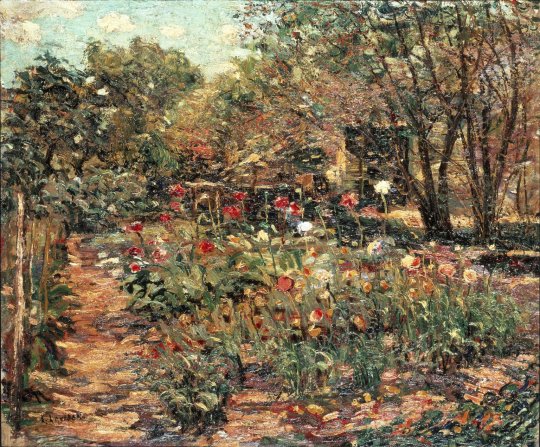
Redolent with the sweet scent of peonies, American Impressionist Ernest Lawson paints his flowerbeds in a dazzling display of jewel like tones in the Cos Cob art-colony located along the Connecticut shore. See the artwork in our open collection.
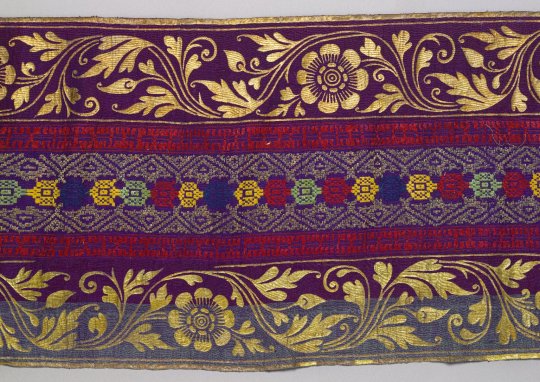
This Balinese cover features bright brocade rosettes in purple, blue, red, yellow, and green. The gilded gold overpaint features patra cina designs borrowed from Chinese floral patterns. Together, they create a glittering textile that is awash with color and floral motifs. See the artwork in our open collection.

One of the Brooklyn Museum’s most important Japanese paintings is a folding screen showing a group of urbanites walking together, followed by a musician and a servant with a big box. The only clue that they are heading to a cherry-blossom-viewing picnic comes from a woman who extends a branch of flowering cherry back toward a group of men. Attached to the branch is a long strip of paper of the type used traditionally in Japan for writing poems. What does the poem strip say? We don’t know, but it seems fair to guess that it serves as an invitation to romance. The screen reminds us that the spring tradition of partying beneath the cherry trees wasn’t solely about communing with nature. See the artwork in our open collection.
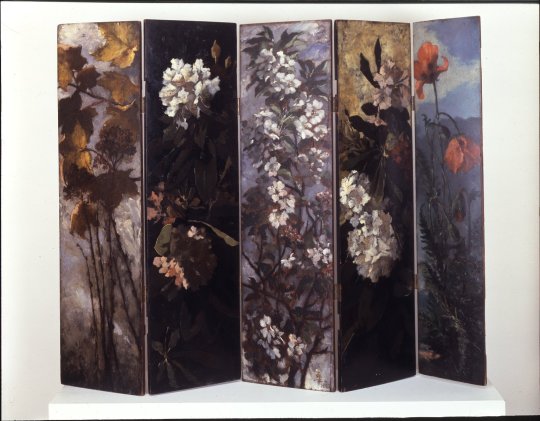
Inspired by Japanese folding screens or byōbu, Elizabeth Boott Duveneck’s five panels bring the natural world into the interior of the house depicting all four seasons from Autumn Foliage to Apple blossoms throughout the year. See the artwork in our open collection.
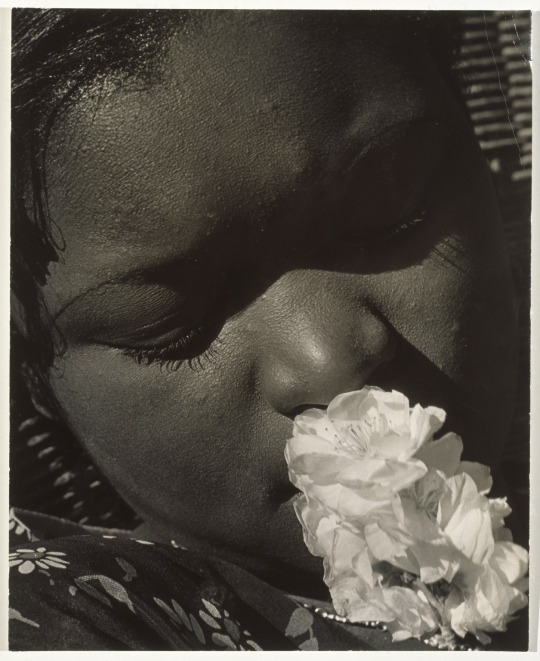
Beginning in the early 1930s, Consuelo Kanaga became one of few white photographers to make artistic portraits of Black Americans. This closely cropped and sharply focused image of a girl’s face with a flower was likely included in Group f.64’s inaugural exhibition in 1932, which announced a new realist direction in photography. Considered radical in its time, Frances with a Flower explores powerful ideas about beauty, gender, and race. See the artwork in our open collection.
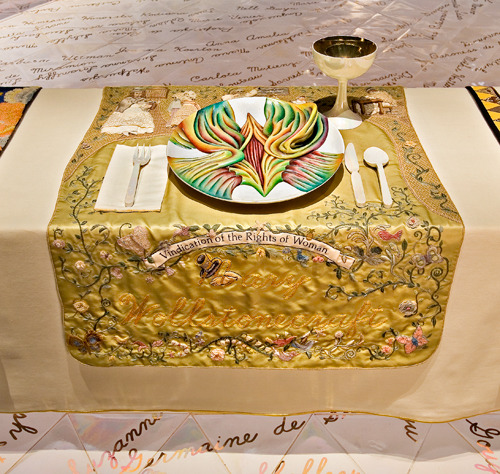
Mary Wollstonecraft was a renowned women’s rights activist who authored "A Vindication of the Rights of Woman," (1792), a classic of rationalist feminism that is considered the earliest and most important treatise, advocating for equality and education for women. Akin to the nature of Spring, Wollstonecraft's life symbolized the fruition of a legacy—from which infinite linages of women continue to reap the fruits of her labor. See the artwork in our open collection.
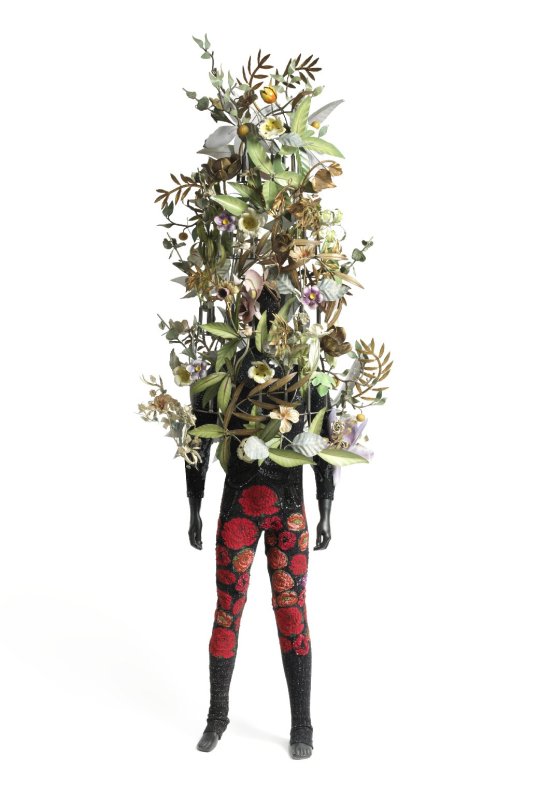
With rose-patterned leggings and an elaborate floral armature/headdress, Nick Cave’s Soundsuit transforms the human body into a lush garden. Since the early 1990s, Cave has been fabricating inventive sculptures out of scavenged materials, which he often overlays with beadwork, stitching, and other embellishments. One of the first, crafted from twigs, was made to be worn and created a rustling sound, which led to the eventual name of such works: Soundsuits. Cave’s costumes draw from a variety of sources, including both African and Caribbean traditions of masquerade. See the artwork in our open collection.
Posted by Nancy Rosoff with contributions from the Curators and Curatorial Assistants of African, American, Ancient Egyptian, Arts of the Americas, Asian, Contemporary, Elizabeth A. Sackler Center for Feminist Art, and Islamic Art
Photos: Gary Alan Bukovnik (American, born 1947). Rhododendrum, 1980. Lithograph on paper. Brooklyn Museum, Gift of the artist, 81.15.2. © Gary Alan Bukovnik(Photo: Brooklyn Museum); Tile with Floral Inlays, ca. 1352-1336 B.C.E. Faience. Brooklyn Museum, Gift of the Egypt Exploration Society, 35.2001. Creative Commons-BY (Photo: Brooklyn Museum); Relief with Desert Scene, ca. 2472-2455 B.C.E. Limestone, pigment. Brooklyn Museum, Charles Edwin Wilbour Fund, 64.147. Creative Commons-BY (Photo: Brooklyn Museum); Nazca. Mantle ("The Paracas Textile"), 100-300 C.E. Cotton, camelid fiber. Brooklyn Museum, John Thomas Underwood Memorial Fund, 38.12; Cuzco School. Saint Joseph and the Christ Child, late 17th-18th century. Oil on canvas. Brooklyn Museum, Museum Expedition 1941, Frank L. Babbott Fund, 41.1275.191 (Photo: Brooklyn Museum); Dogon. Nommo Figure with Raised Arms, 11th-15th century (possibly). Wood, organic sacrificial material. Brooklyn Museum, The Adolph and Esther D. Gottlieb Collection, 1989.51.39. Creative Commons-BY (Photo: Brooklyn Museum); Octagonal Tile Depicting Peacock in Prunus Tree, 16th century. Ceramic; fritware, painted in black, cobalt blue, green, and manganese purple under a transparent glaze. Brooklyn Museum, Gift of Jack A. Josephson, 1990.21. Creative Commons-BY (Photo: Brooklyn Museum); Tiffany Studios (1902-1932). Dawn in the Woods in Springtime, 1905. Stained glass window. Brooklyn Museum, Gift of All Souls Bethlehem Church, 2014.17.1. Creative Commons-BY; Herter Brothers (American, 1865-1905). Chest-of-Drawers, ca. 1880. Ebonized cherry, other woods, modern marble top, brass. Brooklyn Museum, Modernism Benefit Fund, 1989.69. Creative Commons-BY (Photo: Brooklyn Museum); Utagawa Hiroshige (Ando) (Japanese, 1797-1858). Suijin Shrine and Massaki on the Sumida River (Sumidagawa Suijin no Mori Massaki), No. 35 from One Hundred Famous Views of Edo, 8th month of 1856. Woodblock print. Brooklyn Museum, Gift of Anna Ferris, 30.1478.35 (Photo: Brooklyn Museum); Gustave Caillebotte (French, 1848-1894). Apple Tree in Bloom (Pommier en fleurs), ca. 1885. Oil on canvas. Brooklyn Museum, Bequest of William K. Jacobs, Jr., 1992.107.2 (Photo: Brooklyn Museum); Woodlands. Child's Cap, ca. 1890s. Velvet, cloth, beads. Brooklyn Museum, Gift of the Edward J. Guarino Collection in memory of Josephine M. Guarino, 2016.11.2. Creative Commons-BY; Robert Delaunay (French, 1885-1941). In the Garden (Dans le jardin), 1904. Oil on canvas. Brooklyn Museum, Gift of Iris and B. Gerald Cantor, 86.28 (Photo: Brooklyn Museum); Ernest Lawson (American, 1873-1939). Garden Landscape, ca. 1915. Oil on canvas. Brooklyn Museum, Bequest of Laura L. Barnes, 67.24.10 (Photo: Brooklyn Museum); Cover, 19th or early 20th century. Silk, pigment. Brooklyn Museum, Dick S. Ramsay Fund, 45.183.110. Creative Commons-BY; Cherry Blossom Viewing Picnic, ca. 1624-1644. Ink, color and gold leaf on paper. Brooklyn Museum, Gift of Frederic B. Pratt, 39.87. Creative Commons-BY (Photo: Brooklyn Museum); Elizabeth Boott Duveneck (American, 1846-1888). Apple Blossoms, 1882. Oil on wood panel. Brooklyn Museum, Gift of Joan Harmen Brown, Mr. and Mrs. William Slocum Davenport, Mrs. Lewis Francis, Samuel E. Haslett, William H. Herriman, Joseph Jefferson IV, Clifford L. Middleton, the New York City Police Department, Mrs. Charles D. Ruwe, Charles A. Schieren, the University Club, Mrs. Henry Wolf, Austin M. Wolf, and Hamilton A. Wolf, by exchange, Frank Sherman Benson Fund, Museum Collection Fund, Dick S. Ramsay Fund, Carll H. de Silver Fund, John B. Woodward Memorial Fund, and Designated Purchase Fund , 2005.54.3 (Photo: Brooklyn Museum); Consuelo Kanaga (American, 1894-1978). Frances with a Flower, early 1930s. Gelatin silver photograph. Brooklyn Museum, Gift of Wallace B. Putnam from the Estate of Consuelo Kanaga, 82.65.10 (Photo: Brooklyn Museum); Judy Chicago (American, b. 1939). The Dinner Party (Mary Wollstonecraft place setting), 1974–79. Mixed media: ceramic, porcelain, textile. Brooklyn Museum, Gift of the Elizabeth A. Sackler Foundation, 2002.10. © Judy Chicago. Photograph by Jook Leung Photography; Nick Cave (American, born 1959). Soundsuit, 2008. Mixed media. Brooklyn Museum, Mary Smith Dorward Fund, 2009.44a-b. © Nick Cave (Photo: Image courtesy of Robilant Voena)
#virtualtour#springtime#spring#brooklyn museum#museums#brooklyn#virtual tour#art#art museum#bkmtours#virtual tours
569 notes
·
View notes
Text

Ann Lee Peebles (born April 27, 1947) is a singer and songwriter known for her albums of the 1970s. Two of her most popular songs are “I Can’t Stand the Rain”, which she wrote with her husband Don Bryant and radio broadcaster Bernie Miller, and “I’m Gonna Tear Your Playhouse Down”. She was inducted into the Memphis Music Hall of Fame.
She was born in Kinloch, Missouri, the seventh child of eleven. As a child, she began singing in the choir of her father’s church and with the family’s group, the Peebles Choir, which opened shows for gospel stars.
She began performing in clubs in St. Louis and joined a revue led by bandleader Oliver Sain. She sang in a club with trumpeter Gene “Bowlegs” Miller.
Her first record, “Walk Away”, written by Sain, reached the R&B chart in 1969, as did the follow-up, “Give Me Some Credit”, and she released an album, This Is Ann Peebles. Her single “Part Time Love”, reached #7 on the R&B chart, and #45 on the pop chart. One of the first songs he wrote for her was “99 Pounds”, “Good things come in small packages/ You’ll have to agree to that”.
She continued to have R&B, including “I Pity the Fool,” “Slipped, Tripped, and Fell in Love,” “Breaking Up Somebody’s Home”, “Somebody’s on Your Case,” and “I’m Gonna Tear Your Playhouse Down”. She was the only female singer on Hi to release a string of albums, including Straight from the Heart and I Can’t Stand the Rain, which contained many tracks that she co-wrote with Bryant. The title track of the latter album, written by Peebles and Bryant with DJ Bernard Miller, was her biggest commercial success, reaching #6 on the R&B chart and #38 on the pop chart.
She took a break from the music industry to spend more time with her family. She returned in 1989 with the album Call Me. She released albums on Rounder Records’ Bullseye Blues subsidiary label. She continued to perform, and in 2006 she released the album Brand New Classics, which consisted of re-recordings of some of her songs in an acoustic style. She joined Cyndi Lauper on a recording of “Rollin’ and Tumblin’” on Lauper’s 11th studio album, Memphis Blues. She gave up performing after a stroke in 2012. #africanhistory365 #africanexcellence
0 notes
Photo










On Sept. 27th 1938, Queen Elizabeth, the world's largest ocean liner was launched on the Clyde.
The Queen Elizabeth was the sister ship of the Queen Mary, which was christened four years earlier, I covered this yesterday.
Unfortunately, her role as a luxury liner was short-lived - with the outbreak of the Second World War the following year, the Queen Elizabeth entered service in February 1940 as a troopship and didn’t return to her original role until October 1946.
The Cunard line’s enormous luxury ocean-goer was built on the river Clyde to sail between Southampton and New York, named after the Queen Consort (later the Queen Mother).
Following the outbreak of World War II, the security of Queen Elizabeth became a major concern for Cunard-White Star and the British Government. It was not safe to keep the ship in Scotland, as it was well known that she was a tempting target for the Luftwaffe.
Queen Elizabeth was painted in military grey before departing Clydebank for what was rumoured to be a short journey to Southampton. However, once in open sea the ship’s course was altered – Queen Elizabeth’s maiden voyage was to New York!
Thus, the untested and untried ship – then the world’s largest ocean liner – made a secret dash across the Atlantic to the safety of America. She arrived unannounced in New York, surprising officials and New Yorkers alike. Queen Elizabeth berthed alongside Queen Mary, Normandie and Mauretania Queen Elizabeth was requisitioned for wartime service on 13 November 1940.
The ship sailed to Singapore where she was refurbished into the world’s largest troop carrier. During the works, defensive armaments and a degaussing coil (to protect against mines) were fitted.
On 11th February, Queen Elizabeth sailed from Singapore bound for Sydney, Australia, arriving ten days later. Here the conversion into troop ship was completed and Queen Elizabeth undertook her first trooping voyage to the Middle East, carrying troops to Suez.
Queen Elizabeth later sailed to Canada, and carried troops to Sydney, while in 1942 the Admiralty considered possible future uses for the Queens. Their trooping capacity meant they were the most valuable large troop transports in service. When the USA entered the war in December 1941, the future use of Queen Elizabeth along with Queen Mary changed. Ultimately, the ships were most valuable operating the trooping service on the North Atlantic, and following a major overhaul Queen Elizabeth commenced this service. She remained in Government requisition for the rest of the war.
At the end of the war, Queen Elizabeth was famous on both sides of the Atlantic. The ship, which had carried over 750,000 troops, now commenced work repatriating those troops as well as the war brides.
Queen Elizabeth was released from Admiralty service in 1946. Her post-war overhaul and refurbishment was carried out both on the Clyde and at Southampton. This overhaul saw luxury passenger interiors installed aboard Queen Elizabeth, in preparation for civilian transatlantic services. Additionally, ship was painted in Cunard livery, while the machinery was overhauled. Queen Elizabeth was given her full sea trials, and then officially accepted by Cunard. The ship made her maiden peacetime passenger voyage to New York on 16 October 1946.
Queen Elizabeth proved a popular ship and over the coming months the ship was well booked. On 17 April 1947, Queen Elizabeth ran aground near Brambles Bank as she made her approach to Southampton in thick fog. The ship was later successfully refloated.
In September 1951 Queen Elizabeth made her 100th peacetime transatlantic crossing. But as more passengers took to airline services, Cunard realised that they needed to upgrade Queen Elizabeth in order to keep her relevant in a changing world with a particular focus on longer duration cruising
As such, during a refurbishment in January 1952 the ship’s fuel capacity was increased allowing her to sail longer distances without refuelling. Additionally air-conditioning was fitted throughout, to allow the ship to undertake voyages into warm climates. Four years later, Queen Elizabeth was fitted with stabilisers, which greatly improved passenger comfort.
When Pan American World Airways flew the first Boeing 707 service across the Atlantic, the future for Queen Elizabeth was in doubt. By 1962 the decline in the number of passengers on the Atlantic shipping service (they had moved their business to airliners) led to an announcement that the ship would be used more and more for cruises.
Cunard gave Queen Elizabeth another major overhaul in Greenock, which involved an interior refurbishment and the creation of an outdoor swimming pool on Queen Elizabeth’s aft deck. This was combined with a new lido area which, it was hoped, would allow the ship to attract more cruise passengers.
Sadly, the 1966 Seaman’s Strike meant that the refreshed ship was laid up in Southampton for a number of weeks, which further impacted on Cunard’s financial viability. On 8 May 1967, Cunard announced the fates of the two Queens. Queen Mary was withdrawn from service later that year, while the Queen Elizabeth was to be retained until Autumn 1968, by which time it was hoped the QE2 would be ready as her replacement.
Queen Elizabeth was initially sold to a group of Philadelphian businessmen, who intended to turn her into a floating hotel in Florida. The ship made her final transatlantic crossing on 5 November 1968 before she was withdrawn from Cunard service.
Once in Florida, the ship was opened to the public, however this venture didn’t last and the ship was closed in late 1969. In 1970 the ship was auctioned and bought by C.Y.Tung, Hong Kong, who planned to convert the liner into the world’s largest Floating University.
Re-named Seawise University, the ship sailed for Hong Kong to be converted. The transformation was almost complete when a series of fires broke out aboard the ship, causing her to burn out and sink in the harbour, a sad end to a beautiful ship.
You can find more pics and info on the link below, including an 8 minute video. Among the pics you will see that although Queen Elizabeth was a luxury liner, it was not this way when it was in service during WW2, troops were crammed into every available space.
28 notes
·
View notes
Text
Five steps of Wikipedia for Sunday, 3rd March 2024
Welcome, ongi etorri, välkommen, ողջու՜յն (voġčuyn) 🤗 Five steps of Wikipedia from "The Merchants Daughter of Bristow" to "10th term Sejm and 11th term Senate of Poland". 🪜👣

Start page 👣🏁: The Merchants Daughter of Bristow "The Merchants Daughter of Bristow is an English broadside ballad from the 17th century about a young woman who defies her father and follows her lover to Italy, where she saves him from religious persecution and execution. Also known as Maudlin the Merchants Daughter. Copies of the broadside can be..."
Step 1️⃣ 👣: Inquisition "The Inquisition was a judicial procedure and a group of institutions within the Catholic Church whose aim was to combat heresy, conducting trials of suspected heretics. Studies of the records have found that the overwhelming majority of sentences consisted of penances, but convictions of unrepentant..."

Image by Joseph-Nicolas Robert-Fleury
Step 2️⃣ 👣: 2019 Sri Lanka Easter bombings "On 21 April 2019, Easter Sunday, three churches in Sri Lanka and three luxury hotels in the commercial capital, Colombo, were targeted in a series of coordinated ISIS-related terrorist suicide bombings. Later that day, two smaller explosions occurred at a housing complex in Dematagoda and a guest..."

Image licensed under CC BY-SA 4.0? by AKS.9955
Step 3️⃣ 👣: 1971 JVP insurrection "The 1971 Janatha Vimukthi Peramuna (JVP) insurrection (also known as the 1971 Revolt) was the first of two unsuccessful armed revolts conducted by the communist Janatha Vimukthi Peramuna (JVP) against the socialist United Front Government of Sri Lanka (then Ceylon) under Prime Minister Sirimavo..."

Image licensed under CC BY-SA 4.0? by Kommune12
Step 4️⃣ 👣: 1947 Polish parliamentary election "Parliamentary elections were held in Poland on 19 January 1947, the first since World War II. According to the official results, the Democratic Bloc (Blok Demokratyczny), dominated by the communist Polish Workers Party (PPR) and also including the Polish Socialist Party (PPS), People's Party (SL),..."
Step 5️⃣ 👣: 10th term Sejm and 11th term Senate of Poland "The 10th term Sejm and the 11th term Senate is the legislature of the Republic of Poland following the 2023 Polish parliamentary election held on 15 October 2023 which returned 460 deputies to the Sejm and 100 senators to the Senate. The Parliament of Poland held its inaugural meeting on 13 November..."

Image licensed under CC BY-SA 3.0 pl? by Adrian Grycuk
0 notes
Text
Neon Genesis Evangelion analysis Chapter 16 Seele, Gehrin, Nerv and…

Seele All-Star Special?
The United nation in the world of NGE is merely an assembly of multinational military forces that finds itself struggling to keep itself together amidst the devastation and strife the Second impact has brought onto the world. As we have discussed in previous chapters, the secret organization Seele was behind this catastrophe. ‘Seele’ is a German word meaning ‘Soul’ and we are shown that there are fifteen members at its highest level. While many believe the correct number to be twelve, in just one single scene in the renewal version episode 24 when they are talking to Kaworu, we see fifteen monoliths.
Because they are loosely based off of the twelve apostles of Jesus twelve seems to be the correct number and perhaps showing fifteen monoliths were a mistake that slipped through the cracks of production. But, I argue that this is born out of attempts to legitimize the Christian symbolism more then it was intended and that there is something that could be said regarding the number of monoliths that we see here. This I will cover in greater detail in the chapter (19) covering Kaworu.
Out of Seele's members, we are familiar with five of them, namely Lorenz Keel, and four others that we do see the face of. All other members are shown only via voice coming from the monoliths that are numbered. Considering that another inspiration for this organization was the Freemasons, the numbers likely refer to their hierarchy or order of admittance.

The face of Lorenz Keel
We are never told where Seele originated from and this secretive origin is canon; not even the residents of the world of NGE know their past. But we still know that they are influential to the point they can mobilize the UN to do their biddings and that work under the guidance of the “Scenario” that is laid out in the Dead seas scroll. The Scrolls also contains the information of the two moons, Lance of Longinus, and the number of angels they are to expect.
Some believe that the scrolls also mention Evangelions, but that is a rumor. There is no evidence to suggest that.

Let us now talk a little about Keel. What kind of person is he? We can tell from the end of Evangelion that half of his body (Maybe more) has been replaced with cybernetic implants. Perhaps the goggle that we always see him wearing might not be a goggle but cybernetic eyes that he uses.
This points to the possibility that Keel is actually older then he seems to be, this leading some to theorize that Seele might be “A group of immortal robot-human hybrids” but due to other members of Seele not being shown in this sequence, we cannot say anything definitive about this argument

The truth of Keel Lorenz
A little side note on the End of Evangelion where we are shown Keel’s mechanical body. While many interpret it as the producers of the series showing us the long time and great effort Seele’s members have invested into achieving HIP, I believe that we can also see this as (at least) Keel being a complex character who speaks of wanting to ‘transcend’ life and death via HIP while having an obsession with life so great that he has chosen to extend his life by artificial methods

The council of HIP
Coming back to our main topic and move onto the scene where we see five of the Seele members. This special meeting is aptly naming the “Human instrumentality Project council special summon” and are conducted among five of the top members of Seele and happens five times throughout the series. The colors on each of their tables symbolize the countries that each of them comes from.
First White for Germany and Keel. Yellow for France (this character shares the VA with Fuyutsuki), Blue for Russia, Green for the U.S, and Red for the UK. In the series itself, we are only told of the country of origin of the Green in episode 14, the rest is information from the Evangelion collection book. Some would have realized that four out of the five mentioned here are the 'Permanent Members of the United Nations Security Council', the difference being China having been replaced by Germany.

Why this choice of a dark room though?
Out of the five nations represented, Germany plays a significant role in the world of Evangelion. Germany suffered one of the biggest damages of the Second Impact, has the 3rd Nerv operations base where both Kaji and Misato worked in the past. Germany was also the country of origin of Asuka and was where she received her training.

In the bible, seven eyes represent the ‘All-knowing’
This is about all we know, thus able to discuss Seele. In the end, they are sort of Deus Ex Machina that is used to explain away financial, influential, political requirements required by Nerv. Even if the viewers complain that "This is unrealistic!", Seele serves to explain it away.
Moving on from Seele, let us now talk about Seele’s subordinate organization Gehrin, and its successor Nerv.

Akagi Naoko, first-generation member of Gehrin
In German, Gehrin means ‘Brain’ and is the name of the organization that Seele gave their line of support after the Second impact. It was an organization that focused mainly on the construction of the Evangelions and was shown building its headquarters in the third Tokyo city (where current Nerv headquarters is located). It was headed by Gendou with the support of Akagi Naoko working as the head researcher. Since the nature of their activities had to be kept a secret, the public was told that Gehrin was a UN subordinate research facility focused on researching ‘Artificial evolution’.
Ironically, this cover identity falls in line perfectly with what they were actually doing. once the goals of constructing Evangelions were achieved, Gehrin disbanded and was replaced with Special operative organization Nerv run by the same people who were in charge of Gehrin. Simply said, the biggest change was their name.

Yet the organization's name was not the only difference these two organizations had. While Gehrin focused on creating the capacity required for using Evangelions and were completely secretive of their activities, Nerv was more public (although with half-truths) of their activities and publicized goal of the organization ‘an organization focused on repelling the angels’. Across the seven operation bases around the world, they focused on achieving ‘peace for humankind’ and even had an active PR department.
Let’s also talk a little about the iconographies of Nerv. Nerv is the root word for Nerve in English and is used in the same way. It refers to the nerve in our body but also to the ‘Nerve to do something’. As an organization that succeeded Gehrin (Brain) and carries out its plans to fight the angels, I believe the name is very apt.
The Nerv logo is a leaf of a fig tree. In the book of Genesis, Eve uses the leaf of the fig tree to cover herself when she felt shame after eating the fruit of knowledge. For Seele and Nerv that operate to undo the original sin, the choice of the fig leaf is also highly fitting.

The passage on the bottom of the logo “God’s in his heaven. All’s right with the world” comes from Robert Browning’s ‘Pippa Passes’ and is a cynical way of saying that even without a god, the world runs well enough on its own.

Commander: Since when did the UN become a toy (Unit – 02) delivery service?
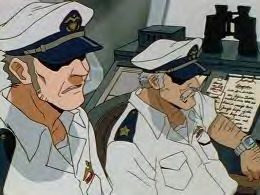
If they had the money to spend on such toys, they should send some funds our way.
While Nerv is considered the UN’s subordinate organization, it appears that this is only concerning the direction of funds flowing towards Nerv. We can see that the UN is in fact under the control of Nerv. This is shown well in Episode 8 when the commander of the fleet complains of the state of things and how powerless he feels following the orders of Nerv. Furthermore, we can see in episode 21’s newspaper that the UN moved its headquarters to the third Tokyo city for convenience. Of course, we know that Nerve has a strong influence only with Seele supporting them. When Seele stopped their support, we all know what has happened to them. So we can say that Nerv was in its best operative condition when they were fighting off the angels. After all, that was what Nerv was made for.
Calendar of important dates in Evangelion
4 Billion BC
Adam arrives on earth
Lilith arrives on earth
First Impact
1947
Dead Seas scroll discovered
9th April 1956
Birth of Fuyutsuki
19th April 1967
Birth of Rokubunki Gendou
30th March 1977
Birth of Ikari Yui
1985
17th June Birth of Kaji Ryoji
21st November Birth of Akagi Ritsuko
8th December 1986
Birth of Katsuragi Misato
11th July 1991
Birth of Ibuki Maya
1999
Fuyutsuki meets Yui
Fuyutsuki meets Gendou
Yui and Gendou begin courtship
2000
12th September Gendou returns to Japan from Antarctica
13th September Second impact
Professor Katsuragi Dies
Birth of Kaworu
15th September India enters into war with Pakistan
20th September Old Tokyo destroyed by a nuclear bomb
2001
14th February Valentine peace treaty signed
6th June Birth of Ikari Shinji
12th September Birth of Aida Kensuke
4th December Birth of Asuka
26th December Birth of Suzuhara Touji
2002
Gendou and Fuyutsuki joins arctic exploration team under UN investigations council
18th February Birth of Horaki Hikari
2003
Construction of Evan begins
Blueprint of Magi drafted
Fuyutsuki joins Gehrin
China – Vietnam war begins
Japanese self-defense force created
2004
Death of Ikari Yui
Ikari Shinji put under the care of ‘Teacher’
Gendou proposes Human instrumentality project
Birth of First Rei
2005
Death of Kyoko Zeppelin
Asuka begins pilot training
Misato meets Ritsuko
Misato begin cohabitation with Kaji
Construction of third Tokyo city begins
2007
UN headquarters moved to Second Tokyo
Misato break up with Kaji
2008
Construction of Magi begins
Ritsuko graduates Second Tokyo university and joins Gehrin
2010
Misato and Kaji joins Gehrin
Magi completes. On the same day, Naoko and First Rei die. By suicide and straggling respectively.
Gehrin becomes Nerv
2012
Ikari Shinji meets his father for the first time in eight-year at Yui’s grave
2014
Ayanami Rei joins the Third Tokyo middle school
Asuka graduates university
Entry plug constructed
2015
Angel advances
TBC Chapter 17 Angel advances
#Neon genesis evangelion#Evangelion#Eva#End of evangelion#Nge#Nagisa Kaworu#Lilith#Sci-fi#Ikari Shinji#Soryu Asuka Langley#asuka#Ayanami Rei#rei#Anno Hideaki#Katsuragi Misato#Anime#Analysis#Review
25 notes
·
View notes
Photo

365 DC Comics Paper Cut-Out Villains - One Villain, Every Day, All Year…
April 11th - The Harlequin
The villainess known as The Harlequin was Molly Mayne, a socialite who harbored a deep infatuation toward the original Green Lantern (Alan Scott). In a desperate bid to gain The Lantern’s attention, Mayne donned a colorful costume and embarked on a life of villainy as The Harlequin. Her crimes tended to be relatively harmless and mostly for show, although she and Green Lantern clashed on several occasions and she managed to become one of the hero’s most persistent foes; she even went so far as to join an iteration of The Injustice Society. At the same time, The Harlequin wasn’t especially villainous by nature and she ended up assisting Green Lantern just as often as she fought against him. Many years later, following the death of his first wife, Alan Scott and Molly Mayne rekindled their unconventional courtship and the two were ultimately married. The Harlequin first appeared in All American Comics #89 (1947).
77 notes
·
View notes
Photo






Released 70 years today April 11th 1947
“Monsieur Verdoux”
His “real” wife Mona played by Audrey Betz, little boy Peter by Allison Roddan & of course the stand out in the film Annabella Boneheur played by Martha Raye.
21 notes
·
View notes